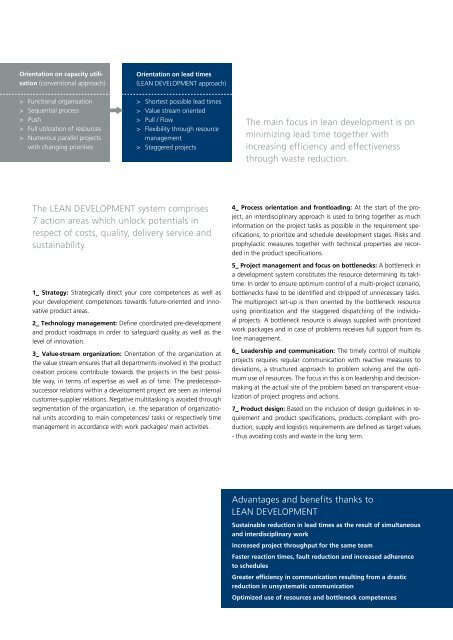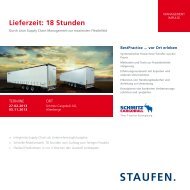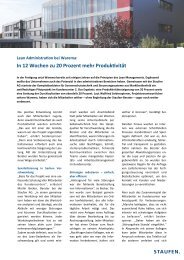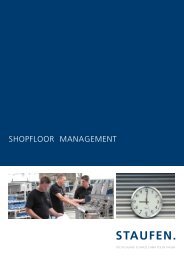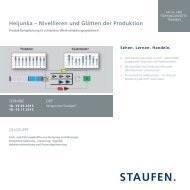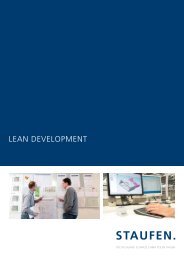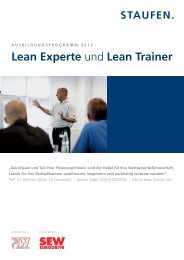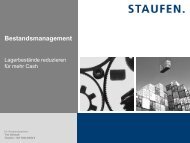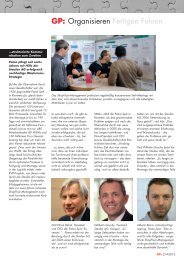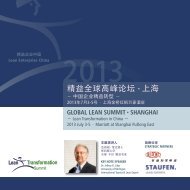Brochure Lean Development - Staufen
Brochure Lean Development - Staufen
Brochure Lean Development - Staufen
Create successful ePaper yourself
Turn your PDF publications into a flip-book with our unique Google optimized e-Paper software.
Orientation on capacity utilisation<br />
(conventional approach)<br />
Orientation on lead times<br />
(LEAN DEVELOPMENT approach)<br />
>> Functional organisation<br />
>> Sequential process<br />
>> Push<br />
>> Full utilization of resources<br />
>> Numerous parallel projects<br />
with changing priorities<br />
>> Shortest possible lead times<br />
>> Value stream oriented<br />
>> Pull / Flow<br />
>> Flexibility through resource<br />
management<br />
>> Staggered projects<br />
The main focus in lean development is on<br />
minimizing lead time together with<br />
increasing efficiency and effectiveness<br />
through waste reduction.<br />
The LEAN DEVELOPMENT system comprises<br />
7 action areas which unlock potentials in<br />
respect of costs, quality, delivery service and<br />
sustainability.<br />
1_ Strategy: Strategically direct your core competences as well as<br />
your development competences towards future-oriented and innovative<br />
product areas.<br />
2_ Technology management: Define coordinated pre-development<br />
and product roadmaps in order to safeguard quality as well as the<br />
level of innovation.<br />
3_ Value-stream organization: Orientation of the organization at<br />
the value stream ensures that all departments involved in the product<br />
creation process contribute towards the projects in the best possible<br />
way, in terms of expertise as well as of time. The predecessorsuccessor<br />
relations within a development project are seen as internal<br />
customer-supplier relations. Negative multitasking is avoided through<br />
segmentation of the organization, i.e. the separation of organizational<br />
units according to main competences/ tasks or respectively time<br />
management in accordance with work packages/ main activities.<br />
4_ Process orientation and frontloading: At the start of the project,<br />
an interdisciplinary approach is used to bring together as much<br />
information on the project tasks as possible in the requirement specifications,<br />
to prioritize and schedule development stages. Risks and<br />
prophylactic measures together with technical properties are recorded<br />
in the product specifications.<br />
5_ Project management and focus on bottlenecks: A bottleneck in<br />
a development system constitutes the resource determining its takttime.<br />
In order to ensure optimum control of a multi-project scenario,<br />
bottlenecks have to be identified and stripped of unnecessary tasks.<br />
The multiproject set-up is then oriented by the bottleneck resource<br />
using prioritization and the staggered dispatching of the individual<br />
projects. A bottleneck resource is always supplied with prioritized<br />
work packages and in case of problems receives full support from its<br />
line management.<br />
6_ Leadership and communication: The timely control of multiple<br />
projects requires regular communication with reactive measures to<br />
deviations, a structured approach to problem solving and the optimum<br />
use of resources. The focus in this is on leadership and decisionmaking<br />
at the actual site of the problem based on transparent visualization<br />
of project progress and actions.<br />
7_ Product design: Based on the inclusion of design guidelines in requirement<br />
and product specifications, products compliant with production,<br />
supply and logistics requirements are defined as target values<br />
- thus avoiding costs and waste in the long term.<br />
Advantages and benefits thanks to<br />
<strong>Lean</strong> <strong>Development</strong><br />
Sustainable reduction in lead times as the result of simultaneous<br />
and interdisciplinary work<br />
Increased project throughput for the same team<br />
Faster reaction times, fault reduction and increased adherence<br />
to schedules<br />
Greater efficiency in communication resulting from a drastic<br />
reduction in unsystematic communication<br />
Optimized use of resources and bottleneck competences


